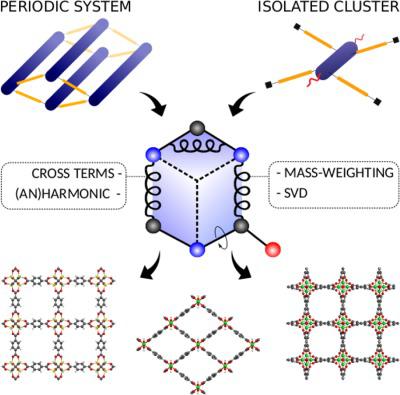当前位置:
X-MOL 学术
›
J. Comput. Chem.
›
论文详情
Our official English website, www.x-mol.net, welcomes your feedback! (Note: you will need to create a separate account there.)
Extension of the QuickFF force field protocol for an improved accuracy of structural, vibrational, mechanical and thermal properties of metal-organic frameworks
Journal of Computational Chemistry ( IF 3 ) Pub Date : 2018-02-02 , DOI: 10.1002/jcc.25173 Louis Vanduyfhuys 1 , Steven Vandenbrande 1 , Jelle Wieme 1 , Michel Waroquier 1 , Toon Verstraelen 1 , Veronique Van Speybroeck 1
Journal of Computational Chemistry ( IF 3 ) Pub Date : 2018-02-02 , DOI: 10.1002/jcc.25173 Louis Vanduyfhuys 1 , Steven Vandenbrande 1 , Jelle Wieme 1 , Michel Waroquier 1 , Toon Verstraelen 1 , Veronique Van Speybroeck 1
Affiliation

|
QuickFF was originally launched in 2015 to derive accurate force fields for isolated and complex molecular systems in a quick and easy way. Apart from the general applicability, the functionality was especially tested for metal–organic frameworks (MOFs), a class of hybrid materials consisting of organic and inorganic building blocks. Herein, we launch a new release of the QuickFF protocol which includes new major features to predict structural, vibrational, mechanical and thermal properties with greater accuracy, without compromising its robustness and transparent workflow. First, the ab initio data necessary for the fitting procedure may now also be derived from periodic models for the molecular system, as opposed to the earlier cluster‐based models. This is essential for an accurate description of MOFs with one‐dimensional metal‐oxide chains. Second, cross terms that couple internal coordinates (ICs) and anharmonic contributions for bond and bend terms are implemented. These features are essential for a proper description of vibrational and thermal properties. Third, the fitting scheme was modified to improve robustness and accuracy. The new features are tested on MIL‐53(Al), MOF‐5, CAU‐13 and NOTT‐300. As expected, periodic input data are proven to be essential for a correct description of structural, vibrational and thermodynamic properties of MIL‐53(Al). Bulk moduli and thermal expansion coefficients of MOF‐5 are very accurately reproduced by static and dynamic simulations using the newly derived force fields which include cross terms and anharmonic corrections. For the flexible materials CAU‐13 and NOTT‐300, the transition pressure is accurately predicted provided cross terms are taken into account. © 2018 Wiley Periodicals, Inc.
中文翻译:

QuickFF 力场协议的扩展,以提高金属有机框架的结构、振动、机械和热性能的准确性
QuickFF 最初于 2015 年推出,旨在以快速简便的方式为孤立和复杂的分子系统推导出准确的力场。除了普遍适用性之外,该功能还特别针对金属-有机框架 (MOF) 进行了测试,MOF 是一类由有机和无机构建块组成的混合材料。在此,我们推出了 QuickFF 协议的新版本,其中包括新的主要功能,可以更准确地预测结构、振动、机械和热特性,而不会影响其稳健性和透明的工作流程。首先,拟合过程所需的 ab initio 数据现在也可以从分子系统的周期性模型中导出,而不是早期的基于簇的模型。这对于准确描述具有一维金属氧化物链的 MOF 至关重要。其次,实现了耦合内部坐标 (IC) 和键和弯曲项的非谐波贡献的交叉项。这些特征对于正确描述振动和热特性至关重要。第三,修改了拟合方案以提高鲁棒性和准确性。新功能在 MIL-53(Al)、MOF-5、CAU-13 和 NOTT-300 上进行了测试。正如预期的那样,周期性输入数据被证明对于正确描述 MIL-53(Al) 的结构、振动和热力学特性至关重要。MOF-5 的体积模量和热膨胀系数通过静态和动态模拟非常准确地再现,使用新派生的力场,包括交叉项和非谐波校正。对于柔性材料 CAU-13 和 NOTT-300,如果考虑到交叉项,则可以准确预测过渡压力。© 2018 Wiley Periodicals, Inc.
更新日期:2018-02-02
中文翻译:

QuickFF 力场协议的扩展,以提高金属有机框架的结构、振动、机械和热性能的准确性
QuickFF 最初于 2015 年推出,旨在以快速简便的方式为孤立和复杂的分子系统推导出准确的力场。除了普遍适用性之外,该功能还特别针对金属-有机框架 (MOF) 进行了测试,MOF 是一类由有机和无机构建块组成的混合材料。在此,我们推出了 QuickFF 协议的新版本,其中包括新的主要功能,可以更准确地预测结构、振动、机械和热特性,而不会影响其稳健性和透明的工作流程。首先,拟合过程所需的 ab initio 数据现在也可以从分子系统的周期性模型中导出,而不是早期的基于簇的模型。这对于准确描述具有一维金属氧化物链的 MOF 至关重要。其次,实现了耦合内部坐标 (IC) 和键和弯曲项的非谐波贡献的交叉项。这些特征对于正确描述振动和热特性至关重要。第三,修改了拟合方案以提高鲁棒性和准确性。新功能在 MIL-53(Al)、MOF-5、CAU-13 和 NOTT-300 上进行了测试。正如预期的那样,周期性输入数据被证明对于正确描述 MIL-53(Al) 的结构、振动和热力学特性至关重要。MOF-5 的体积模量和热膨胀系数通过静态和动态模拟非常准确地再现,使用新派生的力场,包括交叉项和非谐波校正。对于柔性材料 CAU-13 和 NOTT-300,如果考虑到交叉项,则可以准确预测过渡压力。© 2018 Wiley Periodicals, Inc.


























 京公网安备 11010802027423号
京公网安备 11010802027423号